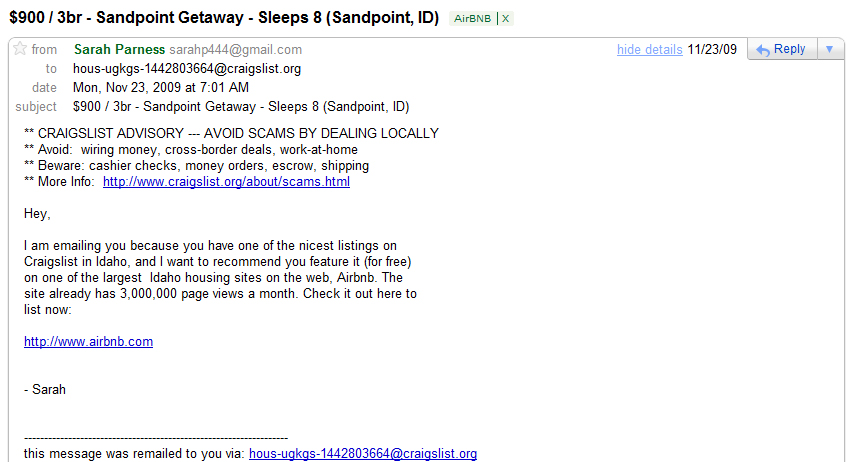Attracting new customers to your business is a science. It is possible to uniquely analyze every campaign and understand the exact reason why it became successful or failed. Here is a comprehensive article that looks into dozens of marketing campaigns targeted at user acquisition to see how these marketers did it. Since getting customers is the hardest in the initial days, we will focus on this segment for this piece.
Yelp – Targeting right
When it comes to marketing, timing is everything. There is no better to this than Yelp. The company launched just when social media was getting mainstream. People were just moving away from traditional outlets like YellowPages to references online from friends and family. Yelp tapped into the third component that was held by companies like YellowPages until then – authority.
Online review platforms were not a new idea by any means and there were dozens of competitors out there. People come to websites like Yelp to read reviews. This meant that the site needed to get these reviews generated in the first place. So what Yelp did was aggressively pursue fanatical reviewers. Unlike competitors of the day who had professional reviewers (who enjoyed higher visibility than regular user reviewers), Yelp encouraged user reviews and gamified the system to reward reviewers with points and badges that motivated people to contribute further.
The content generated helped in two ways – it improved the site’s authority on the internet and this brought Yelp higher rankings on Google search. Also, visitors who came to the site this way stuck around because there was enough content to help them make a decision.
Uber – Word-of-mouth marketing
Uber was not an overnight success by any means. The company launched in 2009. Two years later in January 2011, the company only had between 3000 to 6000 users who had among them completed around 20,000 trips. Not bad for a startup, but nothing impressive. For perspective, Uber has around 40 million monthly riders today.
But the first 6000 users that Uber acquired were crucial. The company targeted San Francisco which is home to the Silicon Valley population. Not only are these users tech-savvy, but the city is also notorious for its poor cab service. A better product coupled with a knowledgeable early adopter base set the stage for Uber to grow from 6000 users to what it is today through sheer word-of-mouth marketing.
Facebook – Exclusivity
How Facebook grew to become what it is today is common knowledge, especially after the movie ‘The Social Network’ came out. Social networking was already popular in 2004 with sites like MySpace and Friendster. Facebook launched its service targeted at Harvard students and subscribers needed a @harvard.edu email address to sign up. This slowly expanded to a select few universities and Facebook opened up to the public only after the initial subscriber base had already made it a popular social networking platform.
Facebook – Product Development
While the initial growth of Facebook is impressive, what is more, impressive is its continued growth that has happened without any real saturation. Facebook’s traffic today is many times more than what Google gets. And one of the main reasons for this is the company’s culture that focuses on growth.
Since its launch and even today, Facebook considers growth as core to its business strategy, and its product development is totally focused on this metric. The company focuses on building functional products – features that solve the users’ needs. These were not features that were added for the sake of it. Instead, they all solved a problem that the user had – newsfeeds improved the news clutter, Facebook chat came in to let live users communicate better, and so on.
And when any of these features became indispensable, they were packaged as separate products (Messenger, Facebook Camera, and so on).
Quora – Connections
Quora is the modern version of Yahoo! Answers that have in-depth answers to questions from every sphere of life. Like it is with every other business, Quora too got its start through invitations sent to family and friends. But that is where the similarity ends. Quora was started by a former CTO of Facebook. So the ‘family and friends’ we are talking about are influential connections who can drive traffic to the website. If you are a nobody with not many connections, that’s a bummer. But this strategy can be used if you are launching your business in an industry where you are already a prominent member. It’s not as unique as it sounds – a lot of people who launch their own consulting business grow their business using this very strategy.
OpenTable – Making your offer irresistible
OpenTable, the website that allows people to book reservations in restaurants was one of the early entrants to the market. It was definitely not the first company to do it. What changed with OpenTable however was that it targeted the right customer with the right kind of offer.
Companies like OpenTable are marketplaces that help the service provider (restaurant owner in this case) meet the service receiver (folks like you and I who go to restaurants). Such marketplace businesses have a chicken-and-egg problem when starting up. OpenTable realized that building a significant base of restaurants was more important than advertising to restaurant-goers. They targeted restaurant owners with irresistible offers – each restaurant that decides to sign up will receive computer systems, installation, and designs for free without any charge.
In effect, restaurants had nothing to lose and OpenTable only took a commission on sales made off their platform. This was a win-win for the restaurant owners and OpenTable which set the ball rolling for its growth.
Airbnb – Packaging
Sometimes, solving a pain point alone is not sufficient to gain traction in your business. Airbnb did a lot of things right when it launched its business. They validated their business by renting out their own flat, targeted the influential crowd visiting SXSW, and so on. Yet, for a long time, their growth in the initial stages stagnated and the founders were making around $200 a week.
What changed then was that the founders realized that the photos that the owners had of their listed houses were not really professional and a lot of potential users turned away because these houses were not pretty. Brian and Joe, the founders, then went about taking professional photos of all these listed houses. That alone helped the duo double their weekly earnings and get set on a growth trajectory. Packaging is indeed a very critical component of your product.
Airbnb – Black hat marketing
While the packaging is one of the many official lines about Airbnb gaining traction, there is also a lot of evidence that points to the team resorting to black hat techniques to gain new listings. More specifically, Airbnb sent thousands of messages to Craigslist listings nudging these real estate owners to list their properties on Airbnb. While we do not know how much this strategy helped, the fact that the company sent thousands of such cold emails is a testament to the fact that this strategy was critical in their growth strategy.

LinkedIn – Top-down approach
LinkedIn launched at a time when social networking had turned mainstream. But instead of competing with the likes of MySpace, Friendster, and Facebook, LinkedIn positioned itself as a business networking website. This category demanded an aspirational audience – would you join a ‘business’ social network that only had job seekers and not enough business owners?
To this end, LinkedIn founder Reid Hoffman seeded the product with influential friends and connections who were top of the pyramid. Investors interested in LinkedIn were asked to hop on to the platform and bring their partners on board as well.
Bringing in people in senior management levels created a sense of aspiration for others to join in. LinkedIn introduced a tool with which users could send an invitation to connect with all their connections on Outlook. This invitation had an expiry which created a sense of urgency among the recipients.
It is obvious that invitations from people in senior management roles to those in junior roles are bound to attract a high conversion rate. And that is how the network got going.
Since its debut in 2014, LinkedIn Sales Navigator has been a top choice for B2B businesses, and with tools that make scraping LinkedIn searches, it is even easier for businesses to generate sales leads.
Foursquare – Publicity
Foursquare is no longer as popular as it once was. There is no doubt however that the check-in platform was touted as the next big thing not too long ago, so it makes sense to see how the service grew to that level in the first place. In short, it was through publicity.
Dennis Crowley, one of the co-founders of Foursquare, also happens to be behind Dodgeball, a location-based social network that was acquired by Google in 2005 (and later shut down in 2009). The acquisition of Dodgeball created enough publicity that when Crowley quit the company to launch Foursquare, it made news too.
Foursquare was timed to launch at SXSW which helped amplify the company’s PR outreach. Although this helped with user acquisition, most of this traffic died down over the next few months. Thereon, Foursquare kept the PR machinery going on each time they launched in a new city – users who had already heard of the service but weren’t users because the service was not available in their city signed up and this helped with sustained user acquisition.
Coursera – Social movement
Coursera started as an experiment within Stanford and aligned with a social movement that a lot of people in the target group can resonate with – free education. The platform allows anybody to access courses and study materials from the best of universities like Stanford, Penn, and John Hopkins University for free. This, by itself, was attractive enough to spread the word about the new startup among its target customers. The company makes money through ‘verified certificates’ that its learners must pay for.
Square – Clearing up bottlenecks
Square offers credit card readers to small businesses that want to accept digital payment but do not want to invest in expensive PoS systems. With Square, merchants could connect a tiny card reader to their smartphone and start accepting payments right away. The fact that Square made this payment so simplified is itself reason enough for so many merchants to adopt their product.
But Square went one step further. They realized that despite the value of the product, merchants still had one bottleneck – purchasing a card reader from Square to start accepting payments. Square cleared this challenge by providing both its card processing app and the necessary hardware for free. This meant that merchants only had to sign up and they would receive the hardware and software for free to use. Square made money through the transaction fees that merchants paid for each sale over the Square platform.
Squarespace – Pay to be seen
Sometimes, you do not need a unique strategy to acquire customers. You could just hop on the most traditional strategy to acquire customers – pay for ads. Squarespace, the website builder platform started in the mid-2000s when founder Anthony Casalena launched with a $30,000 investment from his father. Anthony started his marketing with a $500/month Adwords budget. Cut to today, the company continues to spend hundreds of thousands of dollars each month on highly targeted keywords like ‘build a website’ or ‘website design’ and this has been their most successful strategy to attract customers.
Besides Adwords, Squarespace has also been investing big time into podcast advertising. Listeners of podcasts that target small business owners are routinely offered special discounts to lure them to the website-building platform.
Dropbox – Virality
While paid ads make sense a lot of times, they are not always the best bet either. Dropbox took the paid ad model for the first two years after launch. While the model did get them a lot of users, the company itself was bleeding money. At one point, the cost of each acquisition was between $233-$388 – that’s for a product that sells for $99 a year.
Dropbox had acquired one million users through PR and advertising. But that was going nowhere. Soon after, the company changed tracks. They introduced viral elements and incentives for users to sign up and “spread the love” – Dropbox-built tools that let users share the product with their network. Also, they announced a two-sided incentive that increased signups by as much as 60%. The epiphany took fourteen months to come but was finally the reason Dropbox could sustain its business.

